-
 Bitcoin
Bitcoin $106,754.6083
1.33% -
 Ethereum
Ethereum $2,625.8249
3.80% -
 Tether USDt
Tether USDt $1.0001
-0.03% -
 XRP
XRP $2.1891
1.67% -
 BNB
BNB $654.5220
0.66% -
 Solana
Solana $156.9428
7.28% -
 USDC
USDC $0.9998
0.00% -
 Dogecoin
Dogecoin $0.1780
1.14% -
 TRON
TRON $0.2706
-0.16% -
 Cardano
Cardano $0.6470
2.77% -
 Hyperliquid
Hyperliquid $44.6467
10.24% -
 Sui
Sui $3.1128
3.86% -
 Bitcoin Cash
Bitcoin Cash $455.7646
3.00% -
 Chainlink
Chainlink $13.6858
4.08% -
 UNUS SED LEO
UNUS SED LEO $9.2682
0.21% -
 Avalanche
Avalanche $19.7433
3.79% -
 Stellar
Stellar $0.2616
1.64% -
 Toncoin
Toncoin $3.0222
2.19% -
 Shiba Inu
Shiba Inu $0.0...01220
1.49% -
 Hedera
Hedera $0.1580
2.75% -
 Litecoin
Litecoin $87.4964
2.29% -
 Polkadot
Polkadot $3.8958
3.05% -
 Ethena USDe
Ethena USDe $1.0000
-0.04% -
 Monero
Monero $317.2263
0.26% -
 Bitget Token
Bitget Token $4.5985
1.68% -
 Dai
Dai $0.9999
0.00% -
 Pepe
Pepe $0.0...01140
2.44% -
 Uniswap
Uniswap $7.6065
5.29% -
 Pi
Pi $0.6042
-2.00% -
 Aave
Aave $289.6343
6.02%
How to analyze the rise of ADX in DMI but does not break through the threshold?
A rising ADX below 25 in crypto suggests strengthening directional movement but not enough to confirm a robust trend, often signaling market indecision or early-stage consolidation.
Jun 16, 2025 at 11:49 pm
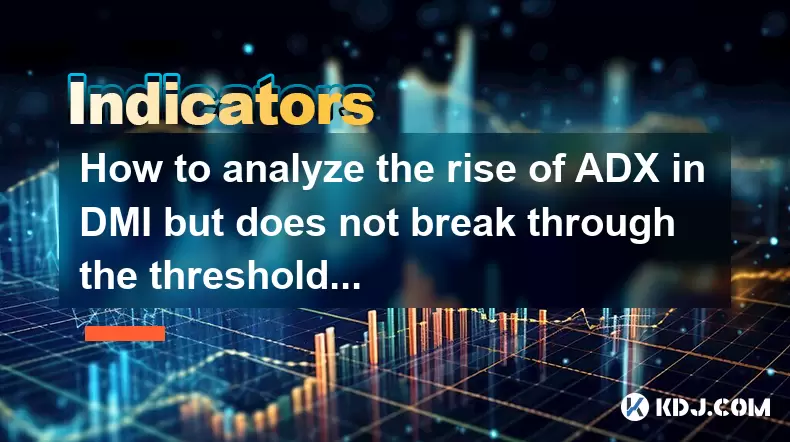
Understanding ADX and DMI in Cryptocurrency Trading
In cryptocurrency trading, ADX (Average Directional Index) is a technical indicator used to measure the strength of a trend. It works in conjunction with the DMI (Directional Movement Indicator), which includes two components: +DI (Positive Directional Indicator) and -DI (Negative Directional Indicator). When ADX rises within the DMI framework but does not cross above 25, it raises questions about the underlying momentum and potential direction of an asset.
Traders often interpret an ADX value above 25 as a confirmation of a strong trend. However, when ADX increases without breaking this threshold, it suggests that while directional movement may be intensifying, the trend itself isn't gaining enough strength to be considered robust or sustainable.
Interpreting Rising ADX Below the 25 Threshold
When ADX climbs but remains below 25, it signals a developing trend that lacks conviction. In the context of cryptocurrencies like Bitcoin or Ethereum, this situation can occur during consolidation phases or early stages of a potential breakout.
One possible explanation for this behavior is increasing volatility without clear directional bias. For example, if +DI and -DI are crossing frequently, it indicates indecision in the market. Even though ADX is rising, reflecting increased directional movement, the lack of a dominant DI line prevents the index from confirming a trend.
This kind of pattern is especially common in altcoin markets, where price action can be erratic due to low liquidity or speculative trading. Traders should look beyond just the ADX and examine other indicators such as volume, RSI, or moving averages to validate any emerging trends.
Key Factors Behind ADX Rise Without Threshold Break
Several factors can contribute to a rising ADX without crossing into trend-confirming territory:
- Short-Term Volatility: Sudden spikes in price due to news or social media buzz can temporarily increase directional movement without establishing a real trend.
- Market Indecision: If buyers and sellers are equally matched, both +DI and -DI may oscillate closely, preventing ADX from surpassing 25 even as it rises.
- Range-Bound Conditions: In sideways markets, price moves within defined support and resistance levels. This environment can cause ADX to rise slightly due to repeated directional shifts but not enough to signal a breakout.
In crypto assets with high volatility, these dynamics can change rapidly. Therefore, traders should monitor price structure, volume patterns, and order flow alongside DMI readings to avoid false signals.
How to Use ADX and DMI Together in Crypto Analysis
To effectively analyze the scenario where ADX rises but does not break 25, you need to integrate multiple aspects of the DMI system:
- Monitor +DI and -DI crossovers: A rising +DI crossing above -DI might suggest bullish momentum, even if ADX hasn’t confirmed the trend. Conversely, a falling -DI crossing below +DI could hint at bearish pressure.
- Observe divergence between price and ADX: If price makes higher highs but ADX fails to do the same, it may indicate weakening momentum despite apparent strength.
- Track historical ADX behavior: Some cryptocurrencies tend to exhibit extended periods of ADX hovering around 20 before a breakout. Identifying such patterns can help anticipate future moves.
For instance, in BTC/USDT on a daily chart, if ADX has been steadily climbing from 18 to 23 over several weeks, it may indicate that institutional interest is building up. While the trend isn’t yet confirmed, the upward trajectory of ADX could serve as a precursor to a breakout.
Practical Steps to Analyze Rising ADX Without Threshold Break
If you're analyzing a cryptocurrency where ADX is rising but has not crossed 25, here's how to proceed methodically:
- Identify recent price action: Look at whether the asset is consolidating, bouncing between support and resistance, or showing signs of accumulation/distribution.
- Compare current ADX with previous cycles: See if similar patterns have occurred before major price moves. Historical data can offer clues about potential outcomes.
- Evaluate volume and order book depth: High volume accompanying ADX rise may suggest real participation, while low volume could point to noise rather than genuine trend development.
- Cross-reference with other indicators: Use RSI, MACD, or Bollinger Bands to confirm or reject the strength of the current move.
- Set alerts for ADX crossovers: Watch for when ADX finally breaks above 25 or when +DI/-DI crosses happen. These can act as triggers for entry or exit points.
By combining these steps, traders can better understand whether a rising ADX is a false alarm or a sign of an imminent trend.
Frequently Asked Questions
What does it mean when ADX rises but stays below 20?
A rising ADX below 20 typically reflects very weak trend strength. It suggests that directional movement is minimal and the market is likely range-bound or experiencing very low volatility.
Can I trade based solely on ADX and DMI readings?
While ADX and DMI provide valuable insights into trend strength and direction, relying solely on them can lead to false signals. Always use them in combination with other tools like volume analysis, candlestick patterns, or moving averages.
Why is ADX rising when price is moving sideways?
ADX measures directional movement regardless of price direction. During sideways movement with frequent swings, ADX can rise because it detects increasing directional activity, even if there’s no clear uptrend or downtrend.
How often should I check ADX values for a cryptocurrency?
The frequency depends on your trading strategy. Day traders may check every few minutes, while swing traders might review ADX on daily or weekly charts. Consistency in time frame is key to accurate interpretation.
Disclaimer:info@kdj.com
The information provided is not trading advice. kdj.com does not assume any responsibility for any investments made based on the information provided in this article. Cryptocurrencies are highly volatile and it is highly recommended that you invest with caution after thorough research!
If you believe that the content used on this website infringes your copyright, please contact us immediately (info@kdj.com) and we will delete it promptly.
- 2025-W Uncirculated American Gold Eagle and Dr. Vera Rubin Quarter Mark New Products
- 2025-06-13 06:25:13
- Ruvi AI (RVU) Leverages Blockchain and Artificial Intelligence to Disrupt Marketing, Entertainment, and Finance
- 2025-06-13 07:05:12
- H100 Group AB Raises 101 Million SEK (Approximately $10.6 Million) to Bolster Bitcoin Reserves
- 2025-06-13 06:25:13
- Galaxy Digital CEO Mike Novogratz Says Bitcoin Will Replace Gold and Go to $1,000,000
- 2025-06-13 06:45:13
- Trust Wallet Token (TWT) Price Drops 5.7% as RWA Integration Plans Ignite Excitement
- 2025-06-13 06:45:13
- Ethereum (ETH) Is in the Second Phase of a Three-Stage Market Cycle
- 2025-06-13 07:25:13
Related knowledge
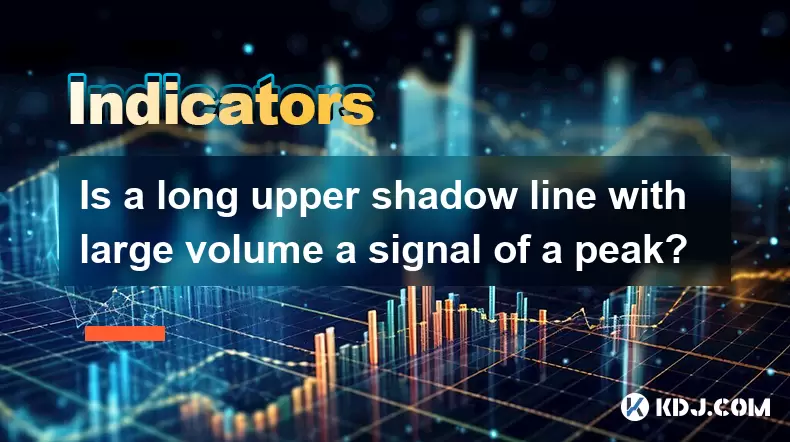
Is a long upper shadow line with large volume a signal of a peak?
Jun 17,2025 at 05:07am
Understanding the Long Upper Shadow LineA long upper shadow line, often referred to as a shooting star or inverted hammer depending on its location in a chart, is a candlestick pattern that indicates potential reversal from an uptrend. This pattern forms when prices rise significantly during the trading period but then fall back to close near the openin...

How to confirm the effectiveness of the average price line support in the time-sharing chart?
Jun 17,2025 at 12:56am
Understanding the Time-Sharing Chart and Its RelevanceIn cryptocurrency trading, time-sharing charts play a crucial role in analyzing short-term price movements. These charts typically display price fluctuations over a specific period, often ranging from minutes to hours. Traders rely on them to make quick decisions based on real-time data. The average ...

What does it mean when the momentum indicator breaks above the zero axis?
Jun 17,2025 at 12:43am
Understanding the Momentum IndicatorThe momentum indicator is a technical analysis tool used to measure the speed or velocity of price movements in cryptocurrency markets. It helps traders identify potential trend reversals, overbought or oversold conditions, and confirms existing trends. The indicator typically oscillates around a zero line, with value...
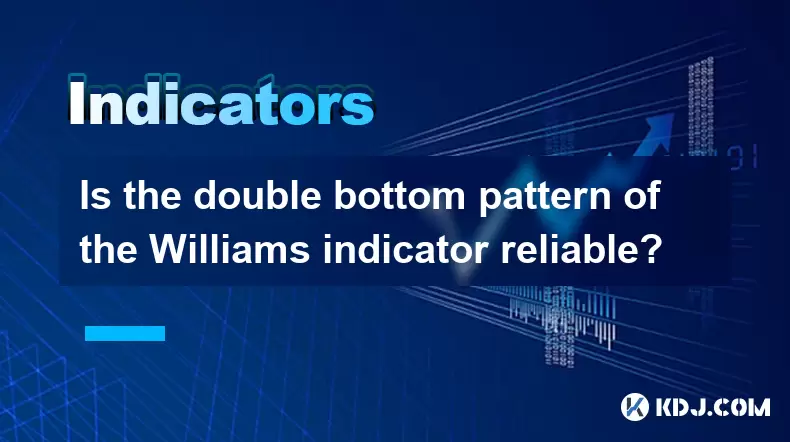
Is the double bottom pattern of the Williams indicator reliable?
Jun 17,2025 at 03:56am
Understanding the Williams Indicator and Its SignificanceThe Williams %R indicator, often referred to as Williams Percent Range, is a momentum oscillator used in technical analysis to identify overbought or oversold conditions in the market. Developed by Larry Williams, this indicator fluctuates between 0 and -100, with readings above -20 indicating ove...
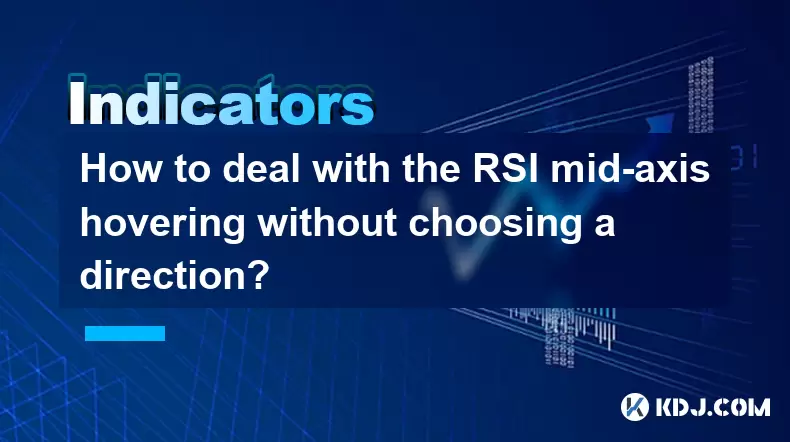
How to deal with the RSI mid-axis hovering without choosing a direction?
Jun 17,2025 at 02:02am
Understanding RSI Mid-Axis Hovering in Cryptocurrency TradingThe Relative Strength Index (RSI) is a popular momentum oscillator used by traders to assess whether an asset is overbought or oversold. In cryptocurrency markets, it's common for the RSI to hover around its mid-axis, typically at the 50 level, without showing a clear upward or downward trend....
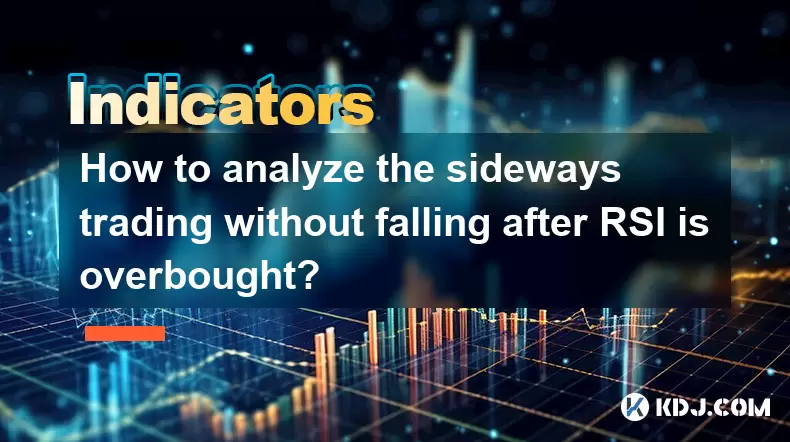
How to analyze the sideways trading without falling after RSI is overbought?
Jun 17,2025 at 04:14am
Understanding RSI and Its Role in Cryptocurrency TradingThe Relative Strength Index (RSI) is a momentum oscillator used to measure the speed and change of price movements. In the context of cryptocurrency trading, it helps traders identify potential overbought or oversold conditions. When the RSI exceeds 70, it typically signals that an asset may be ove...

Is a long upper shadow line with large volume a signal of a peak?
Jun 17,2025 at 05:07am
Understanding the Long Upper Shadow LineA long upper shadow line, often referred to as a shooting star or inverted hammer depending on its location in a chart, is a candlestick pattern that indicates potential reversal from an uptrend. This pattern forms when prices rise significantly during the trading period but then fall back to close near the openin...

How to confirm the effectiveness of the average price line support in the time-sharing chart?
Jun 17,2025 at 12:56am
Understanding the Time-Sharing Chart and Its RelevanceIn cryptocurrency trading, time-sharing charts play a crucial role in analyzing short-term price movements. These charts typically display price fluctuations over a specific period, often ranging from minutes to hours. Traders rely on them to make quick decisions based on real-time data. The average ...

What does it mean when the momentum indicator breaks above the zero axis?
Jun 17,2025 at 12:43am
Understanding the Momentum IndicatorThe momentum indicator is a technical analysis tool used to measure the speed or velocity of price movements in cryptocurrency markets. It helps traders identify potential trend reversals, overbought or oversold conditions, and confirms existing trends. The indicator typically oscillates around a zero line, with value...

Is the double bottom pattern of the Williams indicator reliable?
Jun 17,2025 at 03:56am
Understanding the Williams Indicator and Its SignificanceThe Williams %R indicator, often referred to as Williams Percent Range, is a momentum oscillator used in technical analysis to identify overbought or oversold conditions in the market. Developed by Larry Williams, this indicator fluctuates between 0 and -100, with readings above -20 indicating ove...

How to deal with the RSI mid-axis hovering without choosing a direction?
Jun 17,2025 at 02:02am
Understanding RSI Mid-Axis Hovering in Cryptocurrency TradingThe Relative Strength Index (RSI) is a popular momentum oscillator used by traders to assess whether an asset is overbought or oversold. In cryptocurrency markets, it's common for the RSI to hover around its mid-axis, typically at the 50 level, without showing a clear upward or downward trend....

How to analyze the sideways trading without falling after RSI is overbought?
Jun 17,2025 at 04:14am
Understanding RSI and Its Role in Cryptocurrency TradingThe Relative Strength Index (RSI) is a momentum oscillator used to measure the speed and change of price movements. In the context of cryptocurrency trading, it helps traders identify potential overbought or oversold conditions. When the RSI exceeds 70, it typically signals that an asset may be ove...
See all articles

























































































